Themed collection JMC A Top Picks web collection: Advances in supercapacitors

Flexible supercapacitors based on carbon nanomaterials
Flexible supercapacitors based on carbon nanomaterials are currently of intense interest for use in portable, light-weight, and wearable electronics.
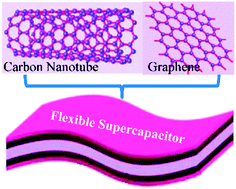
J. Mater. Chem. A, 2014,2, 10756-10775
https://doi.org/10.1039/C4TA00567H
Layered transition metal dichalcogenides for electrochemical energy generation and storage
Layered transition metal dichalcogenides (TMDs) (MoS2, MoSe2, WS2, WSe2, etc.) are a chemically diverse class of compounds having remarkable electrochemical properties.

J. Mater. Chem. A, 2014,2, 8981-8987
https://doi.org/10.1039/C4TA00652F
Graphene-based nanocomposites for energy storage and conversion in lithium batteries, supercapacitors and fuel cells
Revolutionary development in the synthesis of graphene and its hybrids has made their use in various devices, like lithium based batteries, supercapacitors and fuel cells, possible.
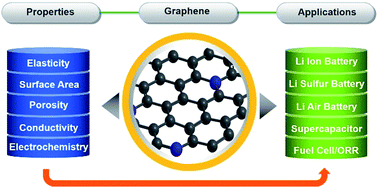
J. Mater. Chem. A, 2014,2, 15-32
https://doi.org/10.1039/C3TA13033A
MnO2-based nanostructures for high-performance supercapacitors
The recent progress, challenges and promising future on design, synthesis and fabrication of MnO2 for supercapacitors are reviewed and discussed.

J. Mater. Chem. A, 2015,3, 21380-21423
https://doi.org/10.1039/C5TA05523G
Vertically aligned graphene nanosheets on silicon using an ionic liquid electrolyte: towards high performance on-chip micro-supercapacitors
Vertically oriented graphene nanosheets were synthesized by an alternative and simple approach based on electron cyclotron resonance-plasma enhanced chemical vapor deposition (ECR-CVD) onto highly doped silicon substrates.
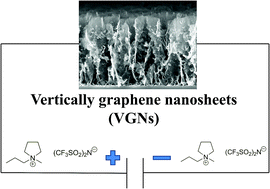
J. Mater. Chem. A, 2015,3, 19254-19262
https://doi.org/10.1039/C5TA04578A
Spray processing of TiO2 nanoparticle/ionomer coatings on carbon nanotube scaffolds for solid-state supercapacitors
A one-step scalable spray technique was used to fabricate solid-state supercapacitors with 3D nanostructured hybrid electrodes.
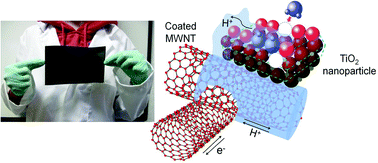
J. Mater. Chem. A, 2014,2, 11022-11028
https://doi.org/10.1039/C4TA02188F
Nanostructured conductive polypyrrole hydrogels as high-performance, flexible supercapacitor electrodes
A spongy polypyrrole based conductive hydrogel with chemically tunable structures and electrochemical characteristics was developed for highly flexible solid-state supercapacitors.
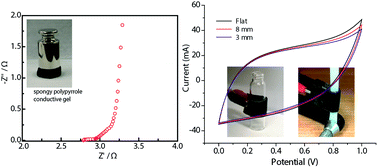
J. Mater. Chem. A, 2014,2, 6086-6091
https://doi.org/10.1039/C4TA00484A
An innovative 3-D nanoforest heterostructure made of polypyrrole coated silicon nanotrees for new high performance hybrid micro-supercapacitors
A micro-supercapacitor electrode made of polypyrrole coated silicon nanotrees.
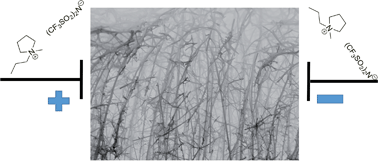
J. Mater. Chem. A, 2015,3, 13978-13985
https://doi.org/10.1039/C5TA03435C
MnO2 nanostructures with three-dimensional (3D) morphology replicated from diatoms for high-performance supercapacitors
The synthesis of MnO2 with unique and complex 3-d morphology replicated from diatoms and their outstanding electrochemical properties for high-performance supercapacitors are demonstrated.
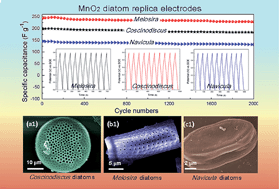
J. Mater. Chem. A, 2015,3, 7855-7861
https://doi.org/10.1039/C5TA00634A
Non-covalent functionalization of reduced graphene oxide using sulfanilic acid azocromotrop and its application as a supercapacitor electrode material
Sulfanilic acid azocromotrop modified reduced graphene oxide was prepared by non-covalent functionalization of graphene oxide followed by post reduction using hydrazine monohydrate.

J. Mater. Chem. A, 2015,3, 7323-7331
https://doi.org/10.1039/C4TA07009G
Synthesis of Ni(OH)2/RGO pseudocomposite on nickel foam for supercapacitors with superior performance
A “pseudocomposite” with unique nano-architecture of two Ni(OH)2/RGO layer was in situ synthesized on nickel foam (NF) using a facile onepot hydrothermal approach, which exhibits superior capacitive performance (15.65 F cm−2 at 7 mA cm−2, 90.6% capacity retention after 5000 cycles at 20 mA cm−2).
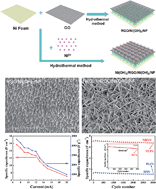
J. Mater. Chem. A, 2015,3, 3641-3650
https://doi.org/10.1039/C4TA06233G
N-doped porous carbon capsules with tunable porosity for high-performance supercapacitors
A procedure for the fabrication of hollow carbon spheres with high nitrogen content and tunable porosity is presented. The carbon capsules exhibited high specific capacitances and a remarkable capacitance retention.
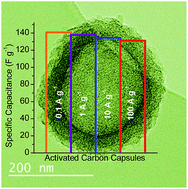
J. Mater. Chem. A, 2015,3, 2914-2923
https://doi.org/10.1039/C4TA06022A
Self-assembled three-dimensional hierarchical graphene hybrid hydrogels with ultrathin β-MnO2 nanobelts for high performance supercapacitors
A facile protocol for the self-assembly of the rGO/β-MnO2 hybrid hydrogel with ultrafine structure and precise control of mass-loading for high performance supercapacitors is reported.
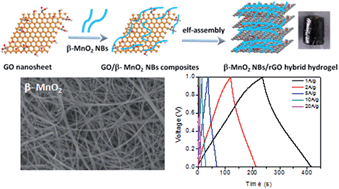
J. Mater. Chem. A, 2015,3, 1540-1548
https://doi.org/10.1039/C4TA04921G
Three-dimensional networked NiCo2O4/MnO2 branched nanowire heterostructure arrays on nickel foam with enhanced supercapacitor performance
Three-dimensional networked NiCo2O4/MnO2 branched nanowire heterostructure arrays directly grown on Ni foam for high-performance electrode application in supercapacitors.

J. Mater. Chem. A, 2015,3, 1717-1723
https://doi.org/10.1039/C4TA05059B
Hierarchical nanosheet-based NiMoO4 nanotubes: synthesis and high supercapacitor performance
Hierarchical nanosheet-based NiMoO4 nanotubes with a high surface area of 128.5 m2 g−1, composed of highly ordered ultrathin nanosheets with a thickness of less than 10 nm, were synthesized by a hydrothermal treatment and a subsequent in situ diffusion reaction method, exhibiting excellent electrochemical performances.
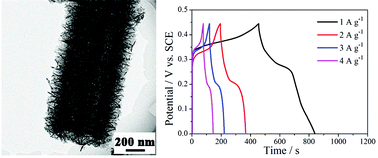
J. Mater. Chem. A, 2015,3, 739-745
https://doi.org/10.1039/C4TA05468G
Fabrication of symmetric supercapacitors based on MOF-derived nanoporous carbons
We design novel symmetric supercapacitors based on nanoporous carbons (NPCs) by direct carbonization of Zn-based metal–organic frameworks (MOFs).
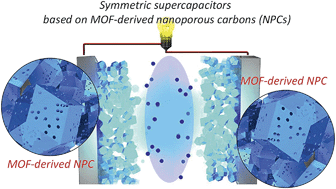
J. Mater. Chem. A, 2014,2, 19848-19854
https://doi.org/10.1039/C4TA04277H
Nanostructured cobalt sulfide-on-fiber with tunable morphology as electrodes for asymmetric hybrid supercapacitors
Porous cobalt sulfide (Co9S8) nanostructures with tunable morphology directly nucleated over carbon fiber are evaluated as electrodes for asymmetric hybrid supercapacitors.
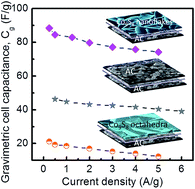
J. Mater. Chem. A, 2014,2, 16190-16198
https://doi.org/10.1039/C4TA03341H
Amorphous Ni(OH)2 @ three-dimensional Ni core–shell nanostructures for high capacitance pseudocapacitors and asymmetric supercapacitors
A complex hydroxide/metal Ni(OH)2@Ni core–shell electrode was developed for a high-performance and flexible pseudocapacitor.
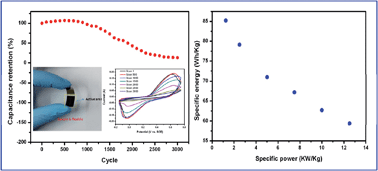
J. Mater. Chem. A, 2014,2, 13845-13853
https://doi.org/10.1039/C4TA02486A
Porous nitrogen-doped hollow carbon spheres derived from polyaniline for high performance supercapacitors
The porous nitrogen-doped hollow carbon spheres derived from polyaniline are promising electrode materials for high performance supercapacitors due to their hierarchical porous structure and nitrogen-doping.
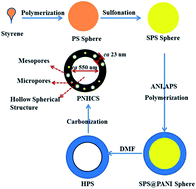
J. Mater. Chem. A, 2014,2, 5352-5357
https://doi.org/10.1039/C3TA15271E
Design of graphene-coated hollow mesoporous carbon spheres as high performance electrodes for capacitive deionization
Graphene-coated hollow mesoporous carbon spheres are rationally designed and originally used as efficient electrode materials for capacitive deionization.

J. Mater. Chem. A, 2014,2, 4739-4750
https://doi.org/10.1039/C3TA15152B
About this collection
This second in a series of JMC A Top Picks web collections focusses on the recent advances in supercapacitors.
Journal of Material Chemistry A’s Associate Editor David Lou (Nanyang Technological University, Singapore) highlights some of the journal’s best research on supercapacitors with crucial applications as an alternative and/or supplementary to lithium ion batteries.
Browse this collection of research articles describing the latest advancemements in carbon materials, electrode design and performance. These well-designed supercapacitors and hybrid supercapacitors can not only deliver high specific capacitance and excellent rate capability but also exhibit high power and energy densities and superb cycling stability.
Great advances have been achieved in this exciting field.